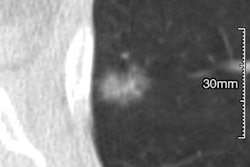Dear CT Insider,
Breast CT is a modality that's always piqued the interest of breast imagers. The technology offers several advantages over conventional mammography, not least of which is the lack of breast compression. Now you can add multispectral imaging to the list of benefits.
Researchers from Duke University Medical Center in Durham, NC, have built an experimental photon-counting breast CT scanner from off-the-shelf parts, including flat-panel photon-counting digital detectors and a powerful x-ray tube. Testing it on phantoms and a cadaver breast, they found that irregularities were easily seen in the high-contrast environment, and radiation doses were quite low.
Of course, the prototype needs more development to solve a few remaining issues. Get the rest of the story before our regular AuntMinnie.com readers can access it in this issue's Insider Exclusive.
Speaking of low radiation doses, research from the University of California concludes that sharing best practices in radiation dose reduction among sites in a far-flung health network can have a huge effect in a short time. A team from the University of California, San Francisco put its top radiologists in a workshop with medical physicists and CT technologists to see how much could be done to optimize and standardize patient doses. A lot could be accomplished, as it turned out.
Meanwhile, another dose study from Duke University found that while it's true that radiation doses from CT are dropping over time, the amounts are small, and individual doses are highly variable.
In CT lung cancer screening, new research confirms the high value of the new 4X classification in the Lung CT Screening Reporting and Data System (Lung-RADS) diagnostic scheme. Writing in Radiology, a team from the Netherlands analyzed hundreds of nodules with the 4X designation and found very high cancer yields. What's the secret? The group isn't exactly sure, as you'll find out here.
Also in CT lung cancer screening comes evidence that those obligatory shared decision-making visits that the U.S. Centers for Medicare and Medicaid Services (CMS) pays for are worth the small cost. Patients who met to discuss whether lung cancer screening was right for them had a far better understanding of the process, according to the findings of a recent survey.
In urologic imaging, researchers from Weill Cornell Medicine who conducted a new meta-analysis argue for the retirement of CT as a first-line diagnostic modality for asymptomatic microscopic hematuria -- to be replaced by ultrasound and cytoscopy. Doing so would save millions of dollars a year, the study authors conclude, at a cost of missing very few cancers. See what led to their conclusions.
In cardiac imaging, CT angiography plus stress myocardial perfusion imaging seems to do the best job at predicting adverse events, according to a study from the U.S. National Institutes of Health. In fact, this combination performed as well as stress imaging plus invasive angiography but without the costs and risks of catheterization.
Finally, in a recent study, color mapping of the cerebral vasculature in head CT angiography saved a lot of time in the setting of acute ischemic stroke -- and might have improved detection sensitivity as well. Click here for the rest of the story.
We invite you to scroll through the links below for the rest of the news in radiology's blockbuster modality, right here in your CT Community.




















